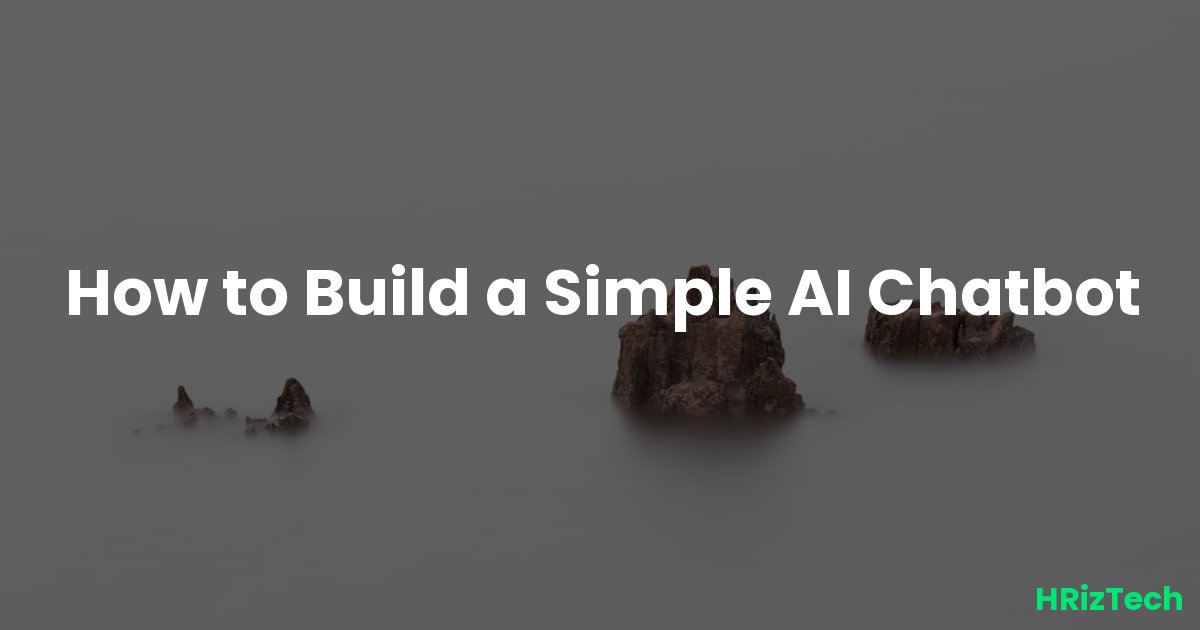How to Build a Simple AI Chatbot

How to Build a Simple AI Chatbot
Ever wondered how those slick AI chatbots on websites work? They're not magic; they're built using readily available tools and a bit of coding know-how. This guide will walk you through building your own simple AI chatbot, demystifying the process and equipping you with the skills to create your own conversational AI assistant. Learning how to build a simple AI chatbot is easier than you think!
Understanding the Fundamentals: What Makes an AI Chatbot Tick?
Before diving into the code, let's grasp the core concepts. At its heart, an AI chatbot uses Natural Language Processing (NLP) and Machine Learning (ML) to understand and respond to human language. NLP helps the chatbot interpret the meaning of your words, while ML allows it to learn and improve its responses over time. This learning process typically involves training the chatbot on a dataset of conversations, enabling it to recognize patterns and generate relevant replies.
Choosing Your Tools: Libraries and Platforms
Several excellent tools simplify chatbot development. Python, with its rich ecosystem of libraries like Rasa and ChatterBot, is a popular choice. These libraries provide pre-built functions for NLP tasks, significantly reducing the amount of code you need to write. Consider also platforms like Dialogflow, which offer user-friendly interfaces for designing and deploying chatbots without extensive coding.
How Do I Start Building an AI Chatbot? A Step-by-Step Guide
Let's build a basic chatbot using Python and the ChatterBot library. This will give you a foundational understanding you can build upon. First, you'll need to install Python and ChatterBot:
- Install Python: Download the latest version from python.org and install it on your system.
- Install ChatterBot: Open your terminal or command prompt and type
pip install chatterbot. This will download and install the necessary packages.
Now, let's create a simple chatbot script:
from chatterbot import ChatBot
from chatterbot.trainers import ListTrainer
chatbot = ChatBot('MyChatbot')
trainer = ListTrainer(chatbot)
conversation = [
"Hello",
"Hi there!",
"How are you doing?",
"I'm doing well, thank you!",
"What's your name?",
"I'm MyChatbot."
]
trainer.train(conversation)
while True:
user_input = input("You: ")
if user_input.lower() == 'bye':
break
response = chatbot.get_response(user_input)
print("Chatbot:", response)
This code creates a chatbot, trains it on a simple conversation, and then allows you to interact with it. Remember to save this as a .py file (e.g., my_chatbot.py) and run it from your terminal using python my_chatbot.py.
Expanding Your Chatbot's Capabilities: Beyond Simple Responses
This basic example only scratches the surface. To create more sophisticated chatbots, you'll need to explore more advanced NLP techniques. This includes using intent recognition to understand the user's goal and entity extraction to identify key information within their message. Consider integrating your chatbot with external APIs to access real-time information or perform specific tasks.
Integrating with External Services: Unlocking New Functionality
Imagine a chatbot that can access weather information, book appointments, or answer questions from a knowledge base. This is achievable by connecting your chatbot to relevant APIs. For instance, you could use a weather API to provide real-time weather updates in response to user queries about the weather.
How to Build a Simple AI Chatbot: Addressing Common Challenges
Building a chatbot isn't always smooth sailing. One common challenge is handling ambiguous or unexpected user input. Your chatbot needs to be robust enough to gracefully handle situations where it doesn't understand the user's request. Consider implementing error handling and fallback mechanisms to provide helpful responses even when the chatbot is unsure.
Dealing with Ambiguity and Unexpected Input
To improve robustness, you can use techniques like fuzzy matching to identify similar phrases even if they aren't exactly the same. You can also train your chatbot on a larger dataset of conversations to increase its ability to handle a wider range of inputs. Proper error handling is crucial for a positive user experience.
The Future of Chatbots and AI: Trends to Watch in 2025
The field of AI is rapidly evolving. A 2025 Gartner report predicts a significant increase in the adoption of AI-powered chatbots across various industries. However, concerns about data privacy and cybersecurity are also rising. As we move towards 2025, expect to see advancements in explainable AI (XAI), making chatbot decision-making more transparent. Furthermore, robust cybersecurity measures will be crucial to protect against potential vulnerabilities.
How do you think AI chatbots will evolve in the next few years? What are the biggest challenges you foresee?
Conclusion: Your Journey into AI Chatbot Development Begins Now
Learning how to build a simple AI chatbot is a rewarding experience. It opens doors to explore the fascinating world of AI and ML. Starting with a basic chatbot like the one we built provides a solid foundation for more complex projects. Remember to leverage the powerful tools and libraries available, and don't be afraid to experiment and iterate. Building your own AI chatbot is a journey of continuous learning and improvement.
What’s your favorite AI tool? Share below!
Comments
No comments yet. Be the first to comment!